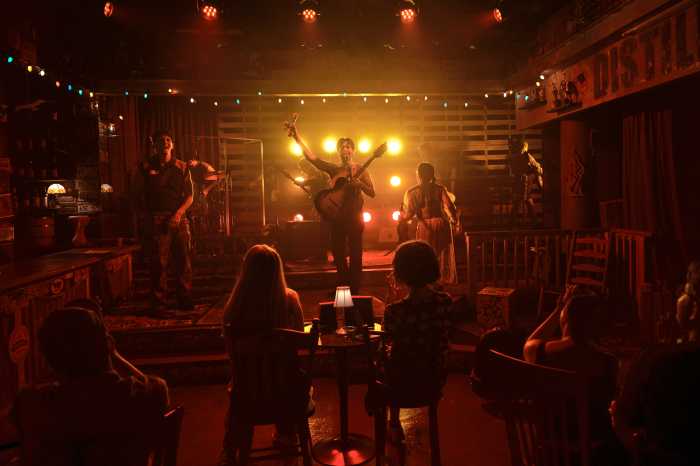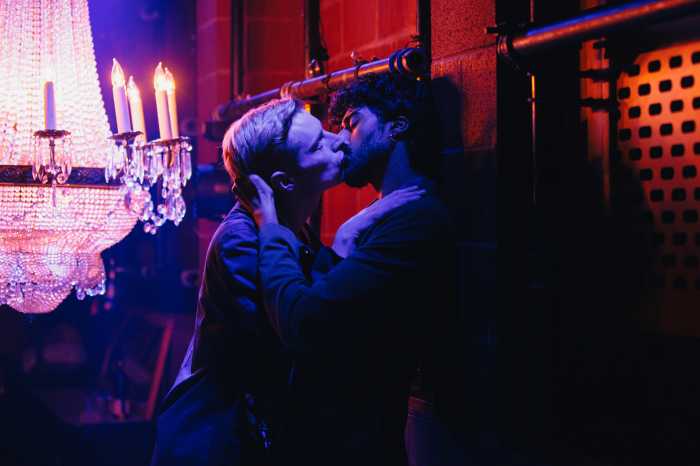Opera Omnia rises on Bleecker; opera-comique served Anne Bogart’s “Carmen” at Glimmerglass
BY ELI JACOBSON
Opera Omnia made a splashy debut in 2008 with a funny, hip presentation of Monteverdi’s “The Coronation of Poppea” at Le Poisson Rouge restaurant cabaret on Bleecker Street and then disappeared.
Small opera companies rise and fall so quickly in this town that I had little hope that Opera Omnia would rise again. But its sophomore effort, Francesco Cavalli’s “Giasone” (1649), just finished its run at Le Poisson Rouge last week with many of the same artists returning after a three-year absence.
Music director Avi Stein provided expert harpsichord continuo leading a well-tuned consort of period instruments. Stage director Crystal Manich stressed the comedy with a lighthearted, minimal, detailed production that at times aimed below the belt (a pink latex sexual aid made a rare operatic appearance). Mezzos Cherry Duke and Hai-Ting Chinn played another pair of amoral royal lovers deceiving each other and their former partners with blithe insouciance.
“Giasone” was Cavalli’s biggest operatic hit and was written for a public opera house in Venice that catered to popular, not aristocratic tastes. Like the Elizabethan theater, sober tragedy and bawdy low comedy co-existed easily, the one commenting on the other.
The opera comes off as a screwball-comedy take on the myth of Jason and Argonauts and their capture of the Golden Fleece with the aid of the enamored barbarian sorceress and princess Medea. The emphasis is on the romantic musical chairs of the royal protagonists, with raunchy running commentary provided by a motley crew of cynical serving wenches, horny soldiers, and bumbling buffoons.
A few haunting laments briefly suspend time, but the dramatic pace is swift-moving, with lots of jaunty short ariosos in rollicking tempos suggestive of 17th century popular tavern songs or dance tunes. After many nearly fatal imbroglios, it all ends happily with a double marriage that stretches credulity and mythological tradition.
The sleek Chinn made a dangerously slinky sex kitten of a Medea. Duke’s oboe-colored mezzo brought nobility to the distinctly ignoble and feckless Jason presented here.
Soprano Katherine Dain was spunky and clueless as the forsaken Queen Hypsipyle; Isai Jess Muñoz and Patrick Murray were amusing buffoons; and Mark Uhlemann and Nathan Baer provided lower voiced solidity as contrasting Argonaut soldiers. Baritone Matthew Singer, in the Ralph Bellamy role of the rejected suitor King Aegeus, scored in his Act III lament. Travesty tenor Karim Suleyman and soprano Sharon Apostolou played the heroines’ serving maids, one jaded and faded, the other young and lusty, and both cynical.
Artistic director Wesley Chinn stressed that “Giasone” was originally presented in the vernacular in an informal environment before a lively audience not averse to drinking, eating, and reveling during the show. The English translation by Paul C. Echols and Martin Morell and the close proximity of the dozen solo singers kept the audience involved and stimulated every moment. Certainly, most operas go down better with a cosmopolitan, though this critic didn’t sample the food menu.
In “Giasone,” Cavalli was aiming to entertain a diverse audience with a bawdy, lighthearted mythological romp. Opera Omnia caught the spirit of fun in a mixture of West Village thrift shop hip informality, cabaret revue sassiness, and elegant early music scholarship.
The Glimmerglass Festival presented “Medea” in her infanticide mode in Cherubini’s opera, while the fatally seductive heroine of Bizet’s “Carmen” explored another facet of the destructive power of female sexuality.
Anne Bogart’s new production of “Carmen” for Glimmerglass was a dreary affair — three shabby distressed walls in various reconfigurations and set dressings that barely filled the stage. Like Richard Eyre at the Met (and Frank Corsaro at NYCO in the early 1980’s), Bogart updated the action to the Spanish Civil War era or the period just prior — the costumes suggested late ‘20s or very early ‘30s.
Ginger Costa-Jackson, the Met’s current successor to Isola Jones as the resident comprimario mezzo sexpot, made a striking role debut as the titular gypsy. Her cat-eyed beauty, air of dangerous self-possession, and dusky mezzo revealed her to be a natural Carmen. Bogart, unfortunately, saddled her with obvious “me so sexy” physical gyrations that the naturally sensual Costa-Jackson did not need. Her velvety lush sound filled out the music convincingly but encountered pitch problems negotiating around the lower break.
Tenor Adam Diegel as Don José revealed an impressive voice and stage presence but seemed oddly bottled up and inhibited. The voice was often as stiff and awkward as his stage demeanor. The Micaela of Anya MatanoviÄ filled the house with pointed, silvery tone and aching pathos in her phrasing. Michael Todd Simpson as Escamillo hit all the notes cleanly in his tricky aria, offering a serviceable baritone and tall imposing stage presence.
The real interest here was the use of the original opera-comique version with spoken dialogue. The small house aided communication and intelligibility despite the inconsistent pronunciation by the cast. The dialogue provides smoother, more convincing transitions into the big musical set pieces, quickens the pace, and includes more background information than the familiar Guiraud recitatives.
The greater balance, clarity, and speed that this production embodied suggest that in smaller theaters with good coaching, this is the performing version of choice.

































